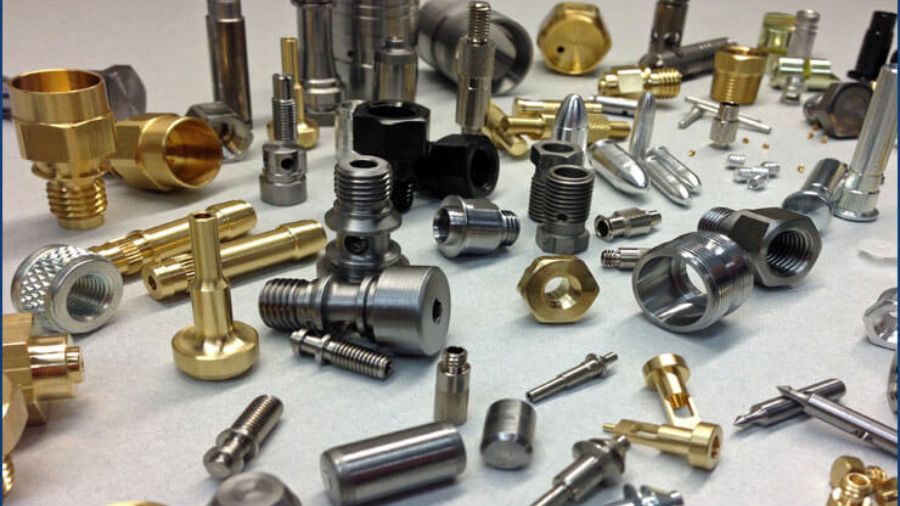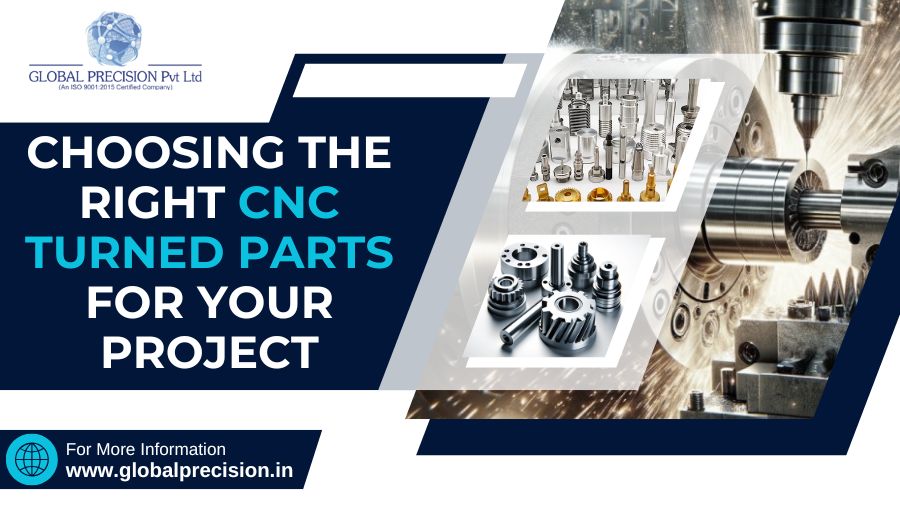CNC turning has emerged as a key technology in contemporary manufacturing, enabling engineers and designers to produce incredibly accurate, repeatable parts. Choosing the right CNC Turned Parts is essential whether you’re creating complex medical devices, durable automotive parts, or advanced aerospace assemblies.
Furthermore, when you require Global Precision, your supplier’s experience may make the difference between a working prototype and a finished product that surpasses performance standards.
Table of Contents
Understanding CNC Turning – A Primer
A cylindrical workpiece rotates while a cutting tool removes material to create the desired shape in CNC turning, also known as lathe machining. Turning is excellent at creating rotationally symmetric geometries, such as shafts, bushings, pins, and intricate multi-diameter parts, in contrast to milling, which mainly cuts linear or planar features. Important advantages include –
1. High Dimensional Accuracy – Turning guarantees that every part satisfies exacting specifications with tolerances frequently as tight as ±0.005 mm.
2. Surface Finish Quality – Post-machining procedures can be minimized by achieving surface finishes as fine as Ra 0.4 µm.
3. Material Versatility – CNC turning can work with a wide range of raw materials, including engineering plastics, titanium, stainless steel, and aluminum alloys.
4. Cost-effective for High Volumes – Gang-tooling configurations and automated tool changers shorten cycle times for extensive production runs.
A manufacturer with a reputation for Global Precision—a fusion of technical expertise, cutting-edge machinery, and strict quality control—is crucial when you need CNC Turned Parts that meet exacting standards.
Key Factors To Consider Before Selecting CNC Turned Parts:

1. Design Requirements and Functional Specifications
Clearly state the functional requirements for your part before contacting a supplier –
- Dimensional Tolerances – To what extent are the tolerances strict? For example, less critical components may permit ±0.02 mm, while aerospace or medical applications frequently require ±0.005 mm.
- Geometric Features – Choose if you require threads, grooves, undercuts, stepped shafts, straight diameters, or intricate profiles. Every feature affects cycle time, tooling needs, and machine setup.
- Surface Finish – Indicate the values of surface roughness (Ra). Functional prototypes have a matte finish, whereas optical components have a polished finish.
- Material Selection – Choose the right material by determining its mechanical qualities, such as strength, resistance to corrosion, or biocompatibility. Materials with different machining properties include nylon, Ti-6Al-4V titanium alloy, POM (Delrin), and 17-4 PH stainless steel.
- Quantity and Volume – Multi-spindle or Swiss-type turning centers are better suited for high-volume production, while general-purpose CNC lathes may be the best option for single prototypes or small batches.
You can ensure that suppliers can deliver CNC Turned Parts that meet your project objectives by laying out these specifications upfront.
2. Material Considerations
Performance, cost, and manufacturability are all directly impacted by the choice of material. Common materials used in CNC turning are listed below, along with important things to keep in mind –
- Aluminum alloys (such as 6061-T6 and 7075-T6) are perfect for electronics and aerospace enclosures because they are lightweight, highly machineable, and resistant to corrosion.
- Stainless steel (such as 304, 316, and 17-4 PH) is used extensively in food processing, medical devices, and marine applications because of its great strength and resistance to corrosion. Keep in mind that stainless steels can work-harden quickly, necessitating the use of cutting feeds and speeds that are optimized.
- Excellent strength-to-weight ratio and biocompatibility make titanium (such as Grade 5 Ti-6Al-4V) ideal for medical implants and aerospace fasteners. However, titanium’s low heat conductivity makes it more difficult to machine.
- Engineering plastics, such as nylon, PEEK, and Delrin, offer electrical insulation, chemical resistance, and low friction. Specialized tools are frequently needed when turning plastic to avoid melting or deformation.
- Brass and bronze are frequently used in electrical connectors, decorative hardware, and plumbing fixtures. Excellent surface finishes are produced by the easy machining of brass.
A supplier who is dedicated to Global Precision will provide in-house knowledge of material selection and counsel you on trade-offs between cost, end-use performance, and machinability.
3. Tolerance and Precision Levels
The selection of the turning process and equipment is significantly influenced by tolerance requirements –
- Normal Tolerances ±0.01 mm to ±0.05 mm – Suitable for consumer product housings, automotive brackets, and general-purpose parts.
- Tight Tolerances (±0.005 mm to ±0.01 mm) – Components in instrumentation, medical devices, and aerospace subsystems must have tight tolerances (±0.005 mm to ±0.01 mm). In-process probing systems and precision-ground tooling are frequently required to achieve these tolerances.
- Near-Net-Shape & Micro-Turning – Specialized Swiss-type lathes can create micro-fluidic nozzles or connector pins with tolerances as fine as ±0.002 mm and diameters as small as 0.5 mm.
When looking for CNC Turned Parts, make sure the equipment portfolio of your supplier includes high-precision spindles, sub-spindle capabilities, and multi-axis lathes with live tooling. Global Precision’s dimensional and surface finish quality are supported by these characteristics.
4. Surface Finish and Secondary Operations
The requirements for surface finish frequently determine whether further procedures are required –
- For internal shafts or unseen features, the As-Turned Finish (Ra 0.8–1.6 µm) is appropriate.
- Mating surfaces and sliding fits frequently use a finely turned finish (Ra 0.4 to 0.8 µm). accomplished by combining optimized feed rates with ceramic or carbide inserts that are sharp.
- For fluidic channels, medical implants, and optical components, a polished finish (Ra ≤ 0.4 µm) is necessary. May entail further buffing or polishing procedures.
- Following turning, parts may need PVD coatings (for wear resistance), electroless nickel plating (for stainless steel), or anodizing (for aluminum).
To deliver fully finished components that satisfy your Global Precision standards, a premier supplier of CNC Turned Parts will either work closely with reliable partners or integrate in-house finishing capabilities.
Evaluating Potential Suppliers
Selecting a supplier is a strategic partnership rather than a simple transaction. The following are important standards to evaluate –
1. Machine and Tooling Capabilities
- Multi-Axis Lathes – At least six-axis lathes with live tooling and sub-spindles should be used by suppliers. These devices significantly cut down on cycle times and possible errors by combining turning, milling, drilling, and tapping into a single setup.
- Swiss-Type Lathes – Swiss machines provide unmatched concentricity and repeatability for large-scale production of small-diameter components (such as watch parts and medical pins).
- Tooling Inventory – Having a large assortment of inserts (carbide, CBN, and ceramic), tool holders, and custom fixtures allows for quicker changeovers and supports a range of geometries and materials.
- In-Process Metrology – The ability of lathes fitted with touch probes and laser measurement systems to confirm crucial dimensions while machining guarantees that every component stays within tolerance, which is a crucial component of Global Precision.
2. Quality Management Systems
- Certifications – Seek out certifications such as ISO 13485 (Medical Devices), AS9100 (Aerospace), or ISO 9001 (Quality Management). These demonstrate a supplier’s dedication to traceability, process standardization, and ongoing development.
- Inspection Tools – For thorough verification, suppliers of CNC Turned Parts should keep track of coordinate measuring machines (CMMs), vision measurement systems, and profilometers.
- Statistical Process Control (SPC) – By identifying patterns in tool wear or machine drift, real-time SPC data enables preventative adjustments before quality problems occur.
- First Article Inspections (FAI) – FAI reports confirm that initial production runs for regulated industries adhere to all design specifications. FAI will be easily incorporated into the workflow of a supplier with Global Precision expertise.
3. Technical Support and Expertise
- DFM Consultation – To minimize cost and cycle time without sacrificing functionality, an experienced engineering team can examine your CAD files, spot possible machining issues, and suggest design changes.
- Advice on Material and Process – In order to ensure that your CNC Turned Parts balance cost, performance, and manufacturability, suppliers should provide information on fixture design, ideal cutting parameters, and material selection.
- Responsive Communication – Quick turnaround times for quotes, design clarifications, and production status updates are made possible by clear channels, such as CAM programmers, support personnel, and dedicated account managers.
Cost Considerations and Lead Times
Although quality is crucial, timely delivery and cost-effectiveness cannot be disregarded –
1. Batch Size and Setup Costs – Because of setup time, small batches (less than 50 pieces) may cost more per unit. On the other hand, larger production runs reduce unit costs by spreading out the setup over more pieces. For large quantities of small parts, Swiss-type turning is particularly economical.
2. Material Costs – Exotic alloys, such as Inconel and Hastelloy, are more expensive. When possible, your supplier should assist you in investigating substitute materials, such as engineering plastics or high-strength aluminum alloys.
3. Tool Wear and Replacement – Materials with a high degree of hardness hasten tool wear. By planning preventive tool changes, a supplier with strong tooling management can reduce unforeseen expenses.
4. Lead Time Optimization – Complexity, material lead times, and machine availability all affect turnaround times. For critical projects and prototyping, a CNC-turned components and parts supplier should provide expedited services without sacrificing quality.
5. Logistics and Shipping – If your business is international, take into account a supplier’s experience with customs paperwork and their proximity to important shipping hubs. Delivering Global Precision entails making certain that components arrive in perfect condition and on time.
Top Strategies For Prolonged Achievement
1. Keep Clear Specifications – Record all measurements, material grades, tolerances, and surface finish specifications. There will be fewer revisions and misunderstandings if your documentation is clear.
2. Use Prototype Iterations – Before committing to high-volume production, you can test form, fit, and function using rapid prototyping on general-purpose lathes.
3. Encourage Cooperation – Consider your CNC supplier to be an extension of your engineering staff. Frequent design reviews and feedback loops cut costs and lead times.
4. Investing in Design for Manufacturability (DFM) – Enables more effective tooling solutions by identifying possible machining challenges early on, such as awkward internal features or deep bore requirements.
5. Plan for Scalability – When choosing machine types, take future volume ramp-ups into account. A supplier can easily move from prototyping to mass production if they have both multi-spindle and Swiss-type lathes. You can prevent cost increases when demand rises by securing competitive pricing in advance.
Your project is set up for success at any scale when these best practices are paired with a supplier renowned for Global Precision and CNC Turned Parts excellence.
Conclusion
Design, material, tolerance, and supplier capabilities must all be carefully considered when choosing CNC-turned components and parts for your project. Working with a manufacturer who exemplifies Global Precision guarantees that every turned part meets your highest standards in a world where accuracy and consistency are unavoidable. The ideal supplier will provide thorough DFM support, strict quality assurance, and open communication from early prototyping on single-spindle lathes to high-volume production on sophisticated Swiss-type machines.
You can successfully negotiate the challenges of CNC turning by following the above recommendations, which include establishing precise specifications, utilizing material knowledge, and working closely with a supplier who is committed to accuracy. The proper CNC Turned Components & Parts ultimately enable your project to realize its maximum potential by optimizing performance, dependability, and cost-efficiency in addition to meeting functional requirements.




